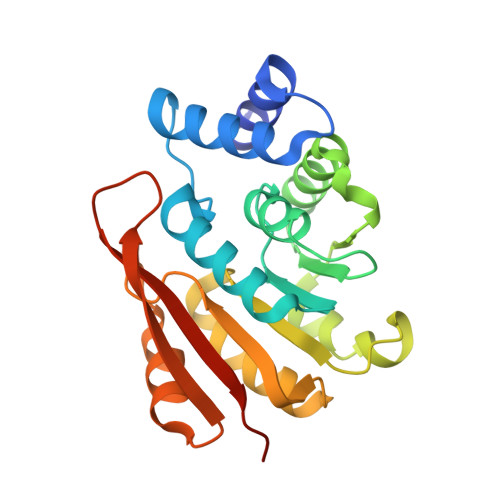Catechol-O-methyltransferase in complex with substituted 3'-deoxyribose bisubstrate inhibitors
Ellermann, M., Lerner, C., Burgy, G., Ehler, A., Bissantz, C., Jakob-Roetne, R., Paulini, R., Allemann, O., Tissot, H., Grunstein, D., Stihle, M., Diederich, F., Rudolph, M.G.(2012) Acta Crystallogr D Biol Crystallogr 68: 253-260
- PubMed: 22349227
- DOI: https://doi.org/10.1107/S0907444912001138
- Primary Citation of Related Structures:
3NWB, 3NWE, 3R6T, 3S68, 3U81 - PubMed Abstract:
The biological activity of catechol neurotransmitters such as dopamine in the synapse is modulated by transporters and enzymes. Catechol-O-methyltransferase (COMT; EC 2.1.1.6) inactivates neurotransmitters by catalyzing the transfer of a methyl group from S-adenosylmethionine to catechols in the presence of Mg²⁺. This pathway also inactivates L-DOPA, the standard therapeutic for Parkinson's disease. Depletion of catechol neurotransmitters in the prefrontal cortex has been linked to schizophrenia. The inhibition of COMT therefore promises improvements in the treatment of these diseases. The concept of bisubstrate inhibitors for COMT has been described previously. Here, ribose-modified bisubstrate inhibitors were studied. Three high-resolution crystal structures of COMT in complex with novel ribose-modified bisubstrate inhibitors confirmed the predicted binding mode but displayed subtle alterations at the ribose-binding site. The high affinity of the inhibitors can be convincingly rationalized from the structures, which document the possibility of removing and/or replacing the ribose 3'-hydroxyl group and provide a framework for further inhibitor design.
- Laboratorium für Organische Chemie, ETH Zürich, Hönggerberg, HCI, CH-8093 Zürich, Switzerland.
Organizational Affiliation:





















